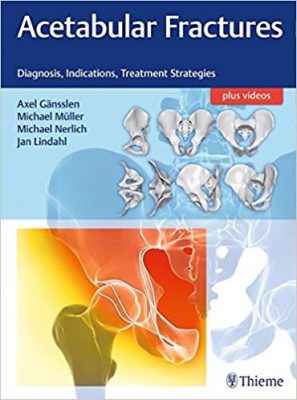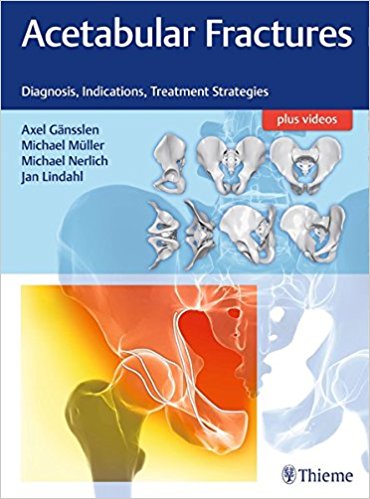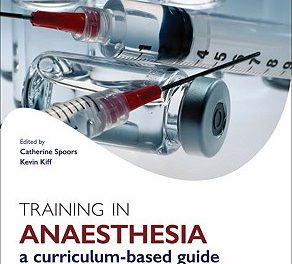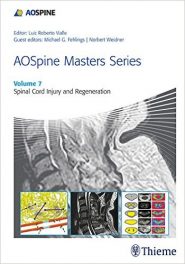 Editors: Axel Gansslen MD, Michael Muller MD, Michael Nerlich MD, and Jan Lindahl, MD
Editors: Axel Gansslen MD, Michael Muller MD, Michael Nerlich MD, and Jan Lindahl, MD
Publisher: Thieme – 339 pages
Book Review by: Nano Khilnani
The acetabulum is the medical term for the complex structure of bones and joints commonly referred to as the hip joint. Acetabular fractures from various types of injury (see chapter 4) or disease sometimes require surgery that can enable the patient to walk in a stable manner and comfortably, and relieve arthritic pain.
When the fractures have caused severe damage, hip replacement surgery is required. Hip replacement is an orthopedic surgical procedure in which the hip joint is replaced by a prosthetic implant, usually made of stainless steel. A Wikipedia article states that a total hip replacement operation cost about $7,700 to $12,000 in 2012 in most European countries, but in the United States it cost an average $40,364. Today it is likely more expensive.
The editors point out in their Preface to this large (9”x12”) book: “Surgery of acetabular fractures is complex and demanding for even experienced surgeons due to its rarity and different fracture types. Its close relationship to relevant neurological structures and the biomechanical significance of the hip joint for typical patient groups – in the younger age group to prevent post traumatic arthrosis and in the older age group resulting in various treatment options including joint reconstruction and primary and secondary endoprothesis – requires a maximum of anatomic and surgical knowledge in order to achieve an optimal long-term outcome.”
For this reason, detailed anatomic, biomechanical, and physiological knowledge of this crucial portion of our body required for motion, is a must. To emphasize their point, they quote in their Preface, someone named Platzer: “Anatomy without clinic is dead – Clinic without anatomy is deadly.”
Twenty-one specialists in orthopedic and trauma surgery mainly from Germany, and also from five other countries – Austria, Croatia, Finland, Slovenia, and the United Kingdom – authored the 25 chapters of this book that we name below to give you an overview of its coverage on acetabular fractures:
- Surgical Anatomy
- Biomechanics
- Radiological Dynamics
- Classification of Acetabular Fractures
- Epidemiology
- Indications and Planning
- Approaches
- Posterior Wall Fractures
- Posterior Column Fractures
- Associated Posterior Column and Posterior Wall Fractures
- Anterior Wall Fractures
- Anterior Column Fractures
- Associated Anterior Column Plus Posterior Hemitransverse Fractures
- Pure Transverse Fractures
- Transverse Plus Posterior Wall Fractures
- T-Type Fractures
- Both-Column Fractures
- Fractures of the Elderly
- Acetabular Fractures in Children
- Heterotopic Ossifications
- Thromboembolic Complications
- Special Screws and Views
- Outcome Scoring
- Femoral head Fractures: Pipkin IV
- Periprostetic Acetabular Fractures
Videos:
- Dissection using Kocher-Langenbeck approach
- Dissection using iliolinguinal approach
- Dissection using intrapelvic approach
- Cadaveric dissection / treatment of a posterior wall fracture
- Cadaveric dissection showing pure transverse fracture treated via an anterior and a posterior approach
Watch the standard approach and selected fracture treatment videos online on this website: www.MediaCenter.Thieme.com. Go to the first page of this book to get your access code.
A review of chapter 7 – Approaches – will give you a good idea of how well the topics are discussed in this book. A larger than usual number of illustrations are provided in this particular chapter, showing you photos of various surgical approaches.
After a brief discussion of how acetabular fractures were treated in the past and how they are done now in the Historical Development section, you are taken to the section entitled Choice of Approach, where such considerations as the following are taken up for each of five approaches :
- Indications
- Contraindications
- Exposure
- Patient Positioning
- Skin Incision
- Superficial Incision
- Deep Incision
- Results
The four main approaches discussed in this chapter, which together comprise over 89 percent of all acetabular operations, are the following:
- Kocher-Langenbeck Approach: 51.9%
- Iliolinguinal Approach: 23.2%
- Extended Iliofemoral (Letournel) Approach: 8.6%
- Triradiate (Mears) Approach:: 5.5%
Other approaches used in situations where they are required are: the Smith-Peterson Approach, the Extended Iliolingual Approach, lateral approaches, the anterior approach, combined approaches (anterior and posterior), the Maryland Modification (Reinert) Approach, and others.
Books on surgery on the acetabulum are rare. This is an excellent text on the classification, diagnosis, and treatment of acetabular fractures by an authoritative group of specialists.
Editors:
Axel Gansslen MD is Consultant Trauma and Orthopedic Surgeon at the Department of Trauma Surgery at Wolfsburg Hospital in Wolfsburg, Germany.
Michael Muller, MD, PD is Chief of the Department of Trauma and Reconstructive Surgery at Bayreuth Hospital in Bayreuth, Germany.
Michael Nerlich, MD is Professor and Chief of the Department of Trauma Surgery at University Hospital Regensburg in Regensburg, Germany.
Jan Lindahl, MD, PhD is Professor and Chief of the Pelvis and Lower Extremity Trauma Unit in the Department of Orthopedics and Traumatology at Helsinki University Central Hospital in Helsinki, Finland.







